This comprehensive guide examines the 21 worst neighbourhoods in Toronto for crime based on recent police statistics. We’ll explore crime data, reputation, demographics, and safety tips for each area—providing an unbiased look at some of Toronto’s areas requiring extra precautions.
It’s important to mention that Toronto overall remains a very safe city. There are no entire neighbourhoods that could be considered dangerous or crime-ridden.
The neighbourhoods described in this guide represent areas with elevated crime rates by Toronto standards. However, these numbers pale in comparison to more notorious cities like Chicago or Detroit.
How We Determined the Worst Neighbourhoods
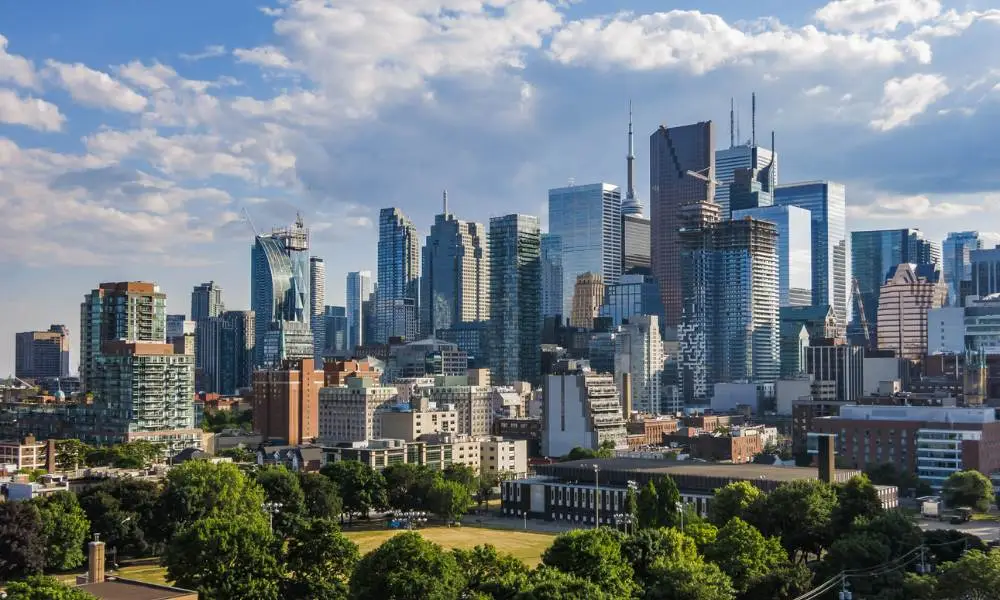
To create this ranking, we analyzed the latest crime statistics published by the Toronto Police Service. These figures include crime rates per 1,000 residents to adjust for population size. We focused specifically on:
- Total crime rate per 1,000 people
- Total property crime rate per 1,000 people
- Violent crime rate per 1,000 people
Neighbourhoods with the highest crime rates across these three categories ranked the worst for safety in Toronto.
In addition to hard numbers, we also considered qualitative factors like neighbourhood reputation and resident sentiment. Areas with higher perceived crime—even if not fully reflected in statistics—ranked as less safe.
Riskiest Places In Toronto
If you live in or visit any Toronto neighbourhood, you’re still unlikely to experience major problems—but it’s helpful to be informed on local crime stats and use reasonable precautions.
21. Leslieville
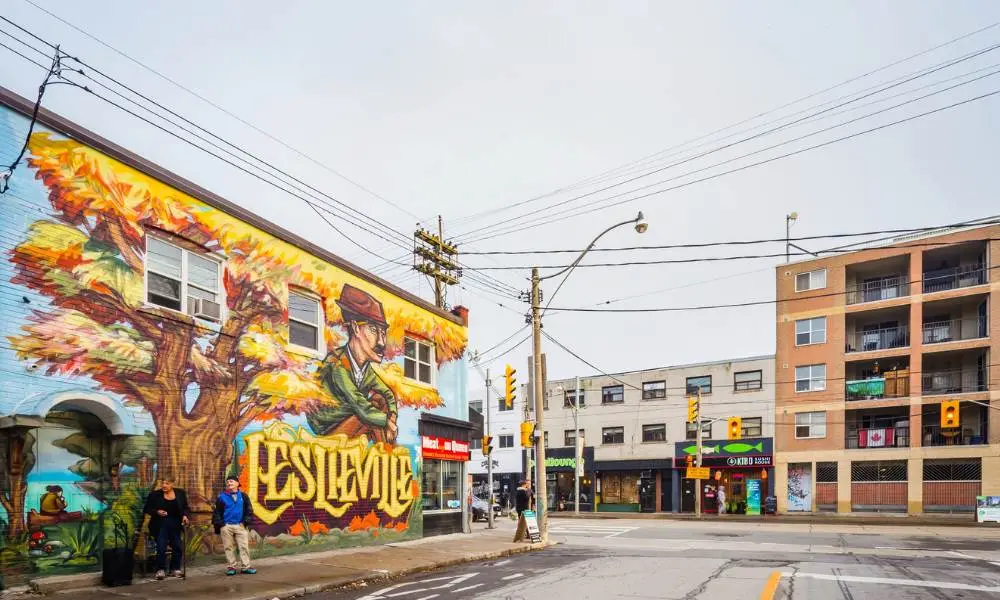
Bordered by the GO Transit railway, Leslieville has seen rising crime rates in recent years. This historically working-class area contains a mix of young families, professionals, and long-time residents.
Crime Stats:
- Total crime rate: 13.55 per 1,000 people
- Property crime rate: 22.22 per 1,000 properties
- Violent crime rate: 2.12 per 1,000 people
Areas near Eastern Avenue and Leslie Street see the most criminal activity. Petty theft and vehicle break-ins are common, especially south of Queen Street East.
As Leslieville gentrifies, crime has also risen. New businesses and wealthier residents attract more property crime. Most incidents involve non-violent theft and vandalism.
Tips for Staying Safe:
- Secure vehicles and bicycles; don’t leave valuables inside
- Keep aware of your surroundings when walking at night
- Consider home security system and exterior lighting
- Report any suspicious activity to police
Despite rising crime rates, Leslieville still retains its vibrant sense of community. Caution and awareness help keep residents safe.
20. Riverdale
Riverdale encompasses the area east of the Don River Valley to Pape Avenue. Its scenic location and family-friendly vibe attract many residents. However, property crime has increased in recent years.
Crime Stats:
- Total crime rate: 16.87 per 1,000 people
- Property crime rate: 32.34 per 1,000 properties
- Violent crime rate: 1.98 per 1,000 people
The neighbourhood experiences high rates of petty theft. Break-ins often target homes and vehicles, especially those with valuables left in plain sight.
As downtown condos become more expensive, Riverdale’s relatively affordable housing draws more residents. With increased density comes more potential for property crime.
Tips for Staying Safe:
- Vary your daily routine and park in well-lit areas
- Install motion sensor lights and a security system
- Keep valuables out of sight; don’t leave garage doors open
- Report people loitering around vehicles or homes
While crime rates have increased, Riverdale still maintains its small-town vibe. Staying vigilant and reporting suspicious activity helps deter future incidents.
19. Humbermede
Humbermede, sometimes called Emery, stretches north from Finch Avenue up to Highway 401. This residential area features parks, schools, and various amenities along Finch.
Crime Stats:
- Total crime rate: 10.71 per 1,000 people
- Property crime rate: 12.88 per 1,000 properties
- Violent crime rate: 1.24 per 1,000 people
The intersection of Lanyard, Rumike, and Sanagan Roads sees higher criminal incidents. The area near Sheppard Avenue and Humber River also reports above-average crime.
Because Humbermede contains many quiet residential streets, property crime like break-ins and vehicle theft occur more often. However, violent offences remain less common.
Tips for Staying Safe:
- Don’t leave garage doors open or valuables in cars
- Install security cameras or alarm systems
- Keep yards and entrances well-lit to deter crime
- Report people casing homes or suspicious vehicles
Despite some property crime, Humbermede remains a relatively safe community. Staying vigilant and securing belongings helps prevent many offences.
18. Roncesvalles
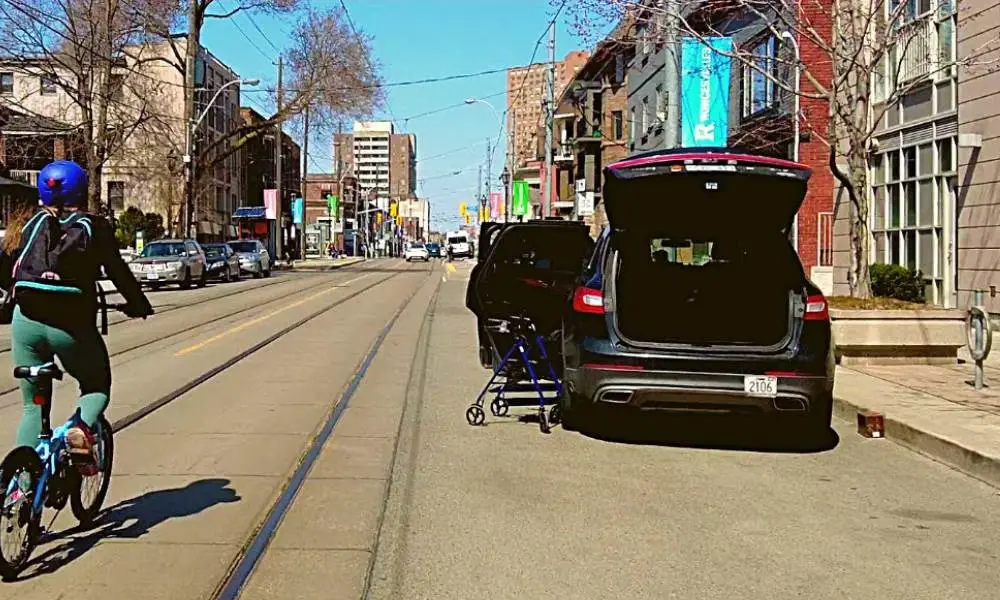
Roncesvalles runs along Roncesvalles Avenue, a historic commercial strip filled with shops and restaurants. Its proximity to High Park attracts many families and young professionals.
Crime Stats:
- Total crime rate: 5.12 per 1,000 people
- Property crime rate: 16.92 per 1,000 properties
- Violent crime rate: 0.77 per 1,000 people
Most criminal activity involves non-violent theft, vehicle break-ins, and vandalism to local businesses. Crowded venues and public transit hubs see more petty crime.
As property values rise, Roncesvalles has experienced some gentrification. New residents and businesses can attract more property offences.
Tips for Staying Safe:
- Secure parked vehicles; don’t leave valuables inside
- Install security systems and exterior lighting
- Walk in groups at night; avoid unlit side streets
- Patronize reputable stores and restaurants
- Report any suspicious vehicles or people around homes
Roncesvalles retains a small-town vibe despite growing density. Remaining vigilant and securing belongings helps deter opportunistic property crime.
17. The Annex
The Annex spans between Bathurst Street and Avenue Road, south of Dupont Street down to Bloor Street. It contains a vibrant mix of families, students, and professionals.
Crime Stats:
- Total crime rate: 8.16 per 1,000 people
- Property crime rate: 23.75 per 1,000 properties
- Violent crime rate: 1.15 per 1,000 people
As a busy downtown neighbourhood, The Annex sees many incidents of petty theft and vandalism. Crowds along Bloor Street attract pickpockets and opportunistic criminals.
Students living off-campus account for some public drunkenness, noise complaints, and nuisance offences. However, violent crime remains less common.
Tips for Staying Safe:
- Secure parked vehicles and bicycles
- Keep aware of your surroundings; avoid flashing expensive items
- Walk in groups at night through well-lit areas
- Consider a home security system
- Report any suspicious activities to police
Despite some petty crime, The Annex retains its vibrant, eclectic reputation. Caution and community vigilance promote public safety.
16. Casa Loma
Casa Loma derives its name from the famed castle and museum within its boundaries. This affluent central neighbourhood features historic homes and scenic ravines.
Crime Stats:
- Total crime rate: 5.93 per 1,000 people
- Property crime rate: 29.23 per 1,000 properties
- Violent crime rate: 0.77 per 1,000 people
Given the number of large, opulent homes, Casa Loma experiences frequent break-ins and thefts. Vandalism also occurs, often targeting high-end vehicles.
However, violent incidents remain less common. Most issues relate to opportunistic property crime. Having expensive homes often attracts more burglaries.
Tips for Staying Safe:
- Install home security systems and cameras
- Keep doors locked; activate alarms when away
- Use exterior lighting and cut back landscape near doors/windows
- Vary your routine; park vehicles in garages overnight
- Report any suspicious vehicles or trespassing
Remaining vigilant and securing homes helps deter future break-ins. Caution is still advised in Casa Loma at night.
15. Forest Hill South
Forest Hill South contains affluent residential streets south of Eglinton Avenue, nestled between Yonge Street and Bathurst Street. Its grand homes and tree-lined streets exude wealth.
Crime Stats:
- Total crime rate: 3.18 per 1,000 people
- Property crime rate: 14.39 per 1,000 properties
- Violent crime rate: 0.17 per 1,000 people
This neighbourhood faces occasional break-ins and thefts targeting high-end homes. Vandalism and petty crimes also occur near commercial areas.
However, violent crime remains extremely rare in Forest Hill South. Most incidents revolve around opportunistic property theft due to affluence.
Tips for Staying Safe:
- Install home security systems and cameras
- Keep valuables in secure locations
- Turn on exterior lights and close garage doors
- Report any suspicious vehicles or trespassing
- Join a neighbourhood watch program
Remaining vigilant and securing homes helps deter more serious property crime. Overall, Forest Hill South remains very safe.
14. Little Portugal
Little Portugal lies west of downtown, encompassing College Street, Dundas Street, landsdowne Avenue, and stretches of Bloor Street. It features vibrant Portuguese culture.
Crime Stats:
- Total crime rate: 8.69 per 1,000 people
- Property crime rate: 23.22 per 1,000 properties
- Violent crime rate: 1.04 per 1,000 people
Theft, vandalism, and public intoxication occur more often in Little Portugal’s commercial areas. Petty crime increases during busy events and weekends as opportunists target crowds.
However, violent offences remain less common. Most crime relates to theft and nuisance violations on busier streets.
Tips for Staying Safe:
- Secure parked vehicles and don’t leave valuables inside
- Keep aware of your surroundings in crowds
- Avoid isolated side streets or alleys at night
- Walk in groups after dark through well-lit areas
- Report suspicious activity to police
Little Portugal retains its vibrant, multicultural community. Being aware and vigilant during events and at night promotes public safety.
13. The Beaches
The Beaches stretch along Queen Street East, encompassing the scenic shoreline and surrounding residential streets. Its small-town vibe and quaint cottages attract many families and professionals.
Crime Stats:
- Total crime rate: 7.8 per 1,000 people
- Property crime rate: 18.2 per 1,000 properties
- Violent crime rate: 1.1 per 1,000 people
During summer, large crowds flock to the waterfront area, leading to more petty theft and public intoxication. Vehicle break-ins also occur near parking lots and side streets.
However, violent offences remain less common year-round. Most incidents relate to crimes of opportunity during busy tourist seasons.
Tips for Staying Safe:
- Secure parked vehicles; don’t leave valuables inside
- Keep valuables hidden from view in crowds
- Travel in groups at night through well-lit areas
- Consider home security systems and exterior lighting
- Report any suspicious activities to police
The Beaches retain their quaint vibe despite high tourist traffic. Remaining vigilant and securing belongings promotes safety.
12. Bay Street Corridor
The Bay Street Corridor spans between Bloor Street and Queens Park, centred along Bay Street through the downtown core. Gleaming office towers and luxury condos characterize the area.
Crime Stats:
- Total crime rate: 4 per 1,000 people
- Property crime rate: 12.51 per 1,000 properties
- Violent crime rate: 0.8 per 1,000 people
As a bustling downtown district, issues like petty theft, vandalism, and public intoxication occur more frequently. Crowds attract pickpockets seeking targets of opportunity.
However, violent offences remain less common. Most incidents relate to minor property crimes and nuisances, rather than serious acts.
Tips for Staying Safe:
- Keep valuables hidden; carry minimal cash
- Walk in groups at night through well-lit areas
- Report intoxicated or suspicious people
- Know which parking garages have security patrols
- Consider home security systems and cameras
The Bay Street Corridor retains its prestigious reputation despite some crime. Staying alert and securing belongings provides effective safety precautions.
11. Weston
Weston lies northwest of downtown, spanning between Lawrence Avenue and Highway 401. A diverse mix of residential areas and industrial zones characterize the neighbourhood.
Crime Stats:
- Total crime rate: 8.5 per 1,000 people
- Property crime rate: 22.45 per 1,000 properties
- Violent crime rate: 1.33 per 1,000 people
Certain areas, like those near Weston Road and Lawrence Avenue, see more criminal activity. Residential break-ins and vehicle thefts occur more often.
Proximity to highways and industrial zones contributes to crimes like vandalism and petty theft. However, violent offences are less common overall.
Tips for Staying Safe:
- Vary your daily routine and keep valuables out of vehicles
- Consider home security systems and exterior lighting
- Walk in groups and stick to main streets at night
- Report any suspicious activities to police promptly
- Join a neighbourhood watch program
While crime rates have risen, Weston retains its diverse small-town vibe. Remaining vigilant and securing property helps deter opportunistic offenders.
10. Moss Park

Moss Park spans several downtown blocks near Queen Street East and Shuter Street. Its proximity to shelters and public housing contributes to higher crime rates.
Crime Stats:
- Total crime rate: 20.81 per 1,000 people
- Property crime rate: 45.94 per 1,000 properties
- Violent crime rate: 4.12 per 1,000 people
Public intoxication, drug use, and homelessness contribute to more incidents of petty crime and violence. However, most violent acts don’t target random people.
Illegal activity tends to centre around housing projects and homeless encampments. But opportunistic thefts still occur, especially near nightlife venues.
Tips for Staying Safe:
- Avoid Moss Park at night; take Uber or taxi instead
- Keep valuables hidden; only carry essentials
- Walk in groups through well-lit areas
- Report any suspicious or illegal activities
- Support local anti-crime initiatives and youth programs
While Moss Park faces challenges with drugs and violence, things are improving through community partnerships. Caution is still essential, but hope remains.
9. Flemingdon Park
Flemingdon Park stretches northeast from Eglinton Avenue to Highway 401, located in the former borough of North York. It features high-rise apartments and residential blocks interspersed with ravine trails.
Crime Stats:
- Total crime rate: 4.19 per 1,000 people
- Property crime rate: 6 per 1,000 properties
- Violent crime rate: 0.45 per 1,000 people
Areas near Flemingdon Park Mall and certain housing blocks see higher rates of assault, robbery, and drug violations. Gang violence also contributes to more serious incidents.
However, most community residents remain law-abiding and want to rejuvenate the area. Crime centres around specific streets rather than throughout.
Tips for Staying Safe:
- Avoid housing blocks with known gang activity
- Report signs of drug dealing or violence promptly
- Join neighbourhood watch groups and safety meetings
- Use well-lit paths and avoid wooded areas at night
- Support youth programs and community growth efforts
While parts of Flemingdon Park face challenges, engaged residents and city initiatives aim to transform the area into a vibrant, safe community.
8. St. James Town
St. James Town encompasses a cluster of high-rise towers northeast of Wellesley and Sherbourne Streets. With over 25,000 residents in a few blocks, it has very high density.
Crime Stats:
- Total crime rate: 10.44 per 1,000 people
- Property crime rate: 24.97 per 1,000 properties
- Violent crime rate: 1.5 per 1,000 people
Packed into crowded towers, residents of St. James Town fall victim to more muggings, petty theft, and disturbance calls. Violent disputes also occur due to close quarters.
However, most long-term residents want to improve community conditions. Crime centres around a small subset of individuals rather than impacting all people.
Tips for Staying Safe:
- Use well-lit paths and avoid isolated areas at night
- Report signs of violence, drug use, or vandalism
- Keep track of building entry; don’t let strangers follow you
- Introduce yourself to neighbours and watch for each other
- Support neighborhood programs and initiatives
While ongoing challenges exist, St. James Town retains a vibrant community feel. Residents take active roles in improving safety over time.
7. Regent Park
Regent Park spans several downtown blocks northeast of Parliament and Gerrard Streets. Its history of concentrated public housing contributed to crime challenges.
Crime Stats:
- Total crime rate: 12.48 per 1,000 people
- Property crime rate: 20.46 per 1,000 properties
- Violent crime rate: 2.81 per 1,000 people
Regent Park faces issues with drugs, gang violence, and muggings—especially near public housing projects. However, crime centres around relatively few individuals.
As revitalization continues, violent crime has dropped steadily each year. Most residents are families and newcomers who actively improve community life.
Tips for Staying Safe:
- Avoid isolated areas and housing projects at night
- Report any drug activity or violence promptly
- Support neighborhood revitalization and youth programs
- Keep track of building entry; don’t let strangers follow
- If moving here, get to know neighbours
Regent Park continues to transform into a more vibrant and safe community through active civic participation.
6. Black Creek
Black Creek encompasses the area northwest of Highway 400 between Steeles and Finch. It contains a mix of residential subdivisions, industrial zones, and retail plazas.
Crime Stats:
- Total crime rate: 8.2 per 1,000 people
- Property crime rate: 10.5 per 1,000 properties
- Violent crime rate: 1.33 per 1,000 people
Areas near strip malls and housing projects tend to have more crime, including break-ins, car theft, and petty vandalism. Gang violence contributes to some street crime and disputes.
However, most parts of Black Creek remain relatively safe for families and workers. Hotspots exist but don’t define the entire neighbourhood.
Tips for Staying Safe:
- Secure vehicles and avoid leaving valuables visible
- Consider home security systems and exterior lighting
- Report signs of gang activity or violence promptly
- Use well-lit streets and avoid alleys at night
- Support community and youth engagement initiatives
While parts of Black Creek face challenges, engaged residents and business owners aim to rejuvenate the community.
5. Scarborough City Centre
Scarborough City Centre spans several blocks northeast of Brimley and Eglinton. This commercial hub features dense condo towers, retail plazas, and transportation links.
Crime Stats:
- Total crime rate: 7.8 per 1,000 people
- Property crime rate: 10.44 per 1,000 properties
- Violent crime rate: 1.6 per 1,000 people
High density and crowds contribute to more issues like muggings, vehicle break-ins, vandalism, and public disturbances. However, violent crime remains relatively low.
Illegal activity focuses around transit terminals and commercial zones. Nearby residential streets are generally safer and quieter.
Tips for Staying Safe:
- Avoid isolated areas near strip malls at night
- Use well-lit paths and consider transit in groups
- Report any signs of violence, disturbances, or vandalism
- Keep valuables out of sight in public
- Support community watch programs
While petty crime occurs in busy areas, most Scarborough City Centre residents feel relatively safe. Remaining vigilant and securing belongings provides effective precautions.
4. Parkway Forest
Parkway Forest comprises residential subdivisions located north of Highway 401 between Warden and Victoria Park. It provides suburban-style living within Toronto.
Crime Stats:
- Total crime rate: 7.1 per 1,000 people
- Property crime rate: 11.2 per 1,000 properties
- Violent crime rate: 0.88 per 1,000 people
Despite suburban appeal, areas closer to the 401 see more break-ins, vehicle thefts, and vandalism. Some gang disputes and robberies also occur, especially near the bus terminal.
However, most criminal incidents involve petty theft and minor property damage. Serious violent crime remains rare throughout Parkway Forest.
Tips for Staying Safe:
- Consider home security systems and street cameras
- Don’t leave valuables visible in vehicles
- Report any trespassers, break-ins, or signs of violence
- Use well-lit streets and avoid wooded trails at night
- Join neighborhood watch programs
Parkway Forest retains a relatively safe, peaceful ambiance despite some property crime concerns near highways.
3. Main Square
Main Square sits northwest of downtown, spanning between Dundas and College Streets west of Ossington. It mixes commercial plazas with mid-rise residential towers.
Crime Stats:
- Total crime rate: 9.55 per 1,000 people
- Property crime rate: 12.77 per 1,000 properties
- Violent crime rate: 1.33 per 1,000 people
Public intoxication, drug violations, robberies, and noise disturbances occur more often around apartment buildings and commercial zones. However, violent disputes are relatively uncommon.
Crime centres around a few troubled tower blocks rather than the entire neighbourhood. Most Main Square residents are families and young professionals.
Tips for Staying Safe:
- Report signs of violence, gangs, or drugs immediately
- Avoid troubled towers; take an Uber or taxi at night
- Keep lobby doors locked; don’t let strangers follow you inside
- Travel along main streets in groups after dark
- Support community initiatives and public safety meetings
While Main Square faces some challenges with drugs and nuisance crimes, things continue improving through civic participation.
2. Crescent Town
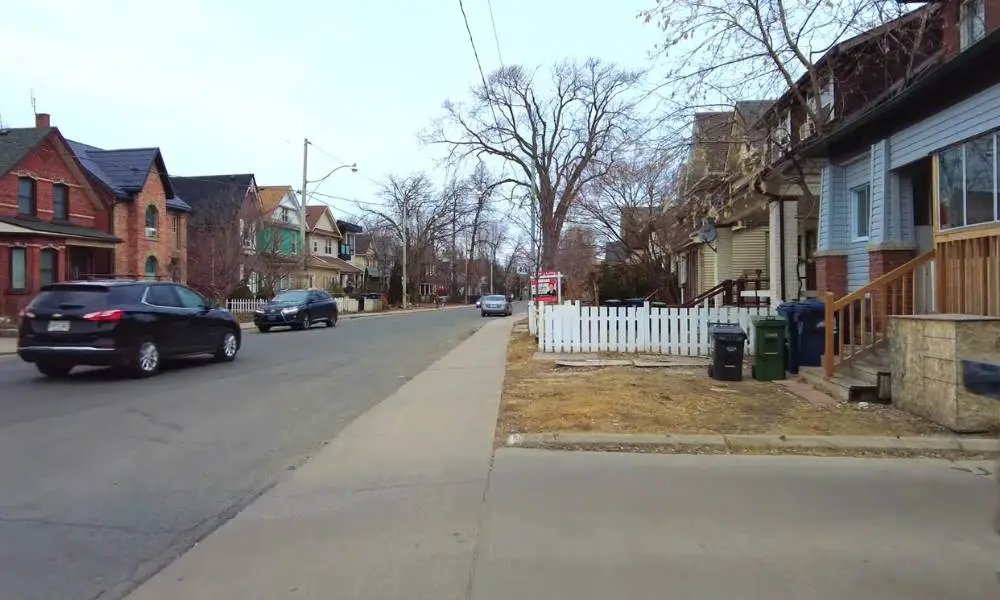
Crescent Town spans several residential blocks northeast of Victoria Park and Danforth Avenue in former East York. High-rise rentals dominate the area landscape.
Crime Stats:
- Total crime rate: 8.55 per 1,000 people
- Property crime rate: 10.9 per 1,000 properties
- Violent crime rate: 1.37 per 1,000 people
The mix of crowded towers, public transit, and strip malls contributes to crimes like petty theft, drug violations, public drunkenness, and violent disputes.
However, most residents are families and newcomers focused on community growth. Illegal activity involves a subset of troublemakers rather than the neighbourhood overall.
Tips for Staying Safe:
- Use main streets at night; avoid isolated areas
- Keep lobby doors locked; don’t allow tailgating
- Report any signs of violence, disputes, or vandalism
- Join neighbourhood watch groups and public meetings
- Support initiatives to engage youth and teens
While Crescent Town faces challenges with drugs and petty crime, engaged residents aim to rejuvenate the community.
1. Parma Court
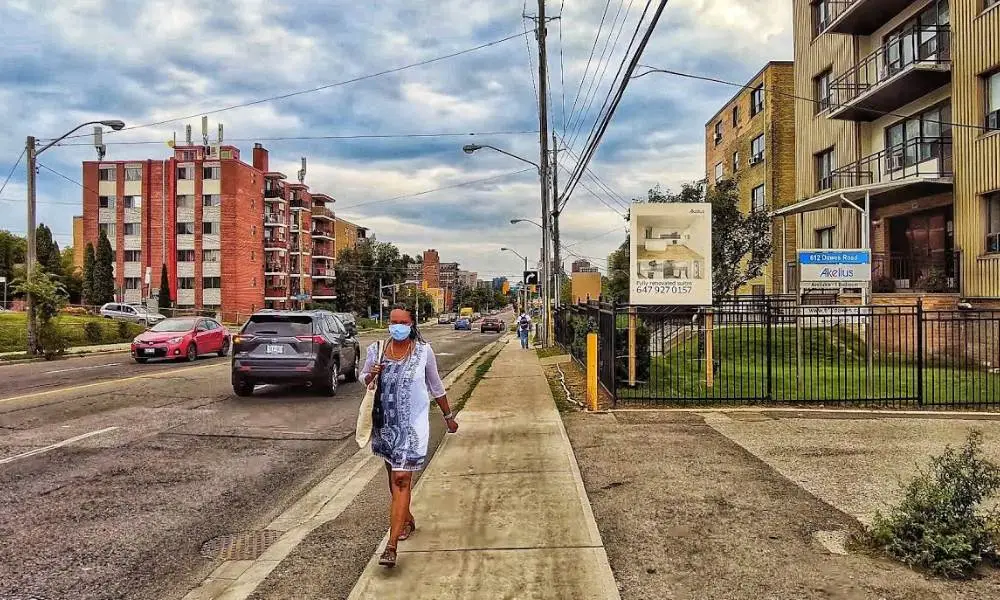
Our list’s top entry, Parma Court comprises TCHC rentals near Victoria Park and Eglinton Avenue East. Ongoing issues with drugs, gang violence, and shootings contribute to crime concerns.
Crime Stats:
- Total crime rate: 12 per 1,000 people
- Property crime rate: 15.5 per 1,000 properties
- Violent crime rate: 2.9 per 1,000 people
Illegal firearms, drug trade, robbery, and noises disturbances remain ongoing issues, especially near certain buildings. However, most residents are law-abiding families concerned for safety.
Despite problems, engaged community members actively report crimes and lobby for improvements. Initiatives aim to provide more youth programs and community support.
Tips for Staying Safe:
- Use main streets at night; avoid isolated areas
- Report illegal activities to Crime Stoppers anonymously
- Follow building rules and keep lobby doors locked
- Introduce yourself to neighbours; watch for each other
- Support community growth efforts and youth initiatives
Parma Court faces substantial challenges with crime and violence. While risks remain, residents and the city work hard to transform community conditions over time.
Frequently Asked Questions
What are the current crime rates in Toronto?
As of 2021, Toronto’s overall crime rate sits at 3,020 criminal code offenses per 100,000 people. The violent crime rate is 1,196 per 100,000 people, while the property crime rate is lower at 1,824 per 100,000 people. Rates have decreased steadily over the past decade.
How do Toronto’s crime rates compare to other major cities?
Compared to other large North American cities, Toronto enjoys relatively low crime rates. For example, Toronto’s violent crime rate is less than half that of U.S. cities like Chicago or Philadelphia.
Property crime is also significantly lower than most other metro areas. Overall, Toronto rates among the safest big cities in North America.
What neighbourhoods have the lowest crime in Toronto?
Areas like The Kingsway, Sunnylea, and Willowridge in Etobicoke exhibit the lowest crime rates in Toronto. Other very safe neighbourhoods include Wychwood Park, Ledbury Park, and Maple Leaf. These areas all report minimal violent crime and property offences.
What type of crimes are most common in Toronto?
According to police reports, the most prevalent crimes in Toronto consist of petty theft under $5,000, theft from vehicles, mischief or vandalism, and break and enters for residences or businesses. Violent offences like assault and robbery occur less frequently overall.
What should I do if witnessing a crime or emergency?
If you witness dangerous or illegal activities, call 911 immediately if possible. Providing details on the incident, people involved, location, weapons, and direction of travel can greatly help police response. If it’s not safe to intervene directly, reporting anonymously through Crime Stoppers also assists investigations once you are in a secure place.
Frequently Asked Questions
In summary, while parts of Toronto see elevated crime compared to the rest of the city, these areas remain far safer than high-crime zones in many US cities.
Practicing basic awareness, securing belongings, avoiding isolated spots at night, and supporting community growth initiatives helps keep all Toronto neighbourhoods safe and livable.
No city of over 2.9 million people comes without some crime challenges. However, Toronto’s overall low crime rates, community vigilance, and responsive police force keep the city among the safest metropolitan areas in North America. Staying informed on local crime stats allows you to appreciate just how secure Toronto really is compared to other big cities.
With a vigilant public, engaged communities, youth outreach initiatives, and responsive law enforcement, Toronto provides exceptional safety and livability for residents and visitors alike. We can cherish this clean, peaceful city while working together to improve problem areas over time.
